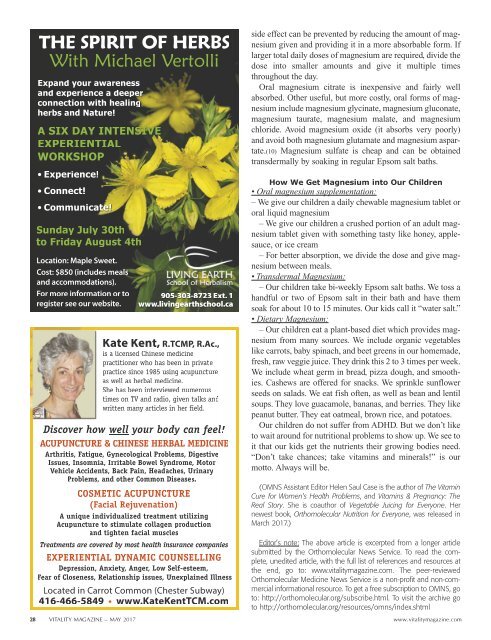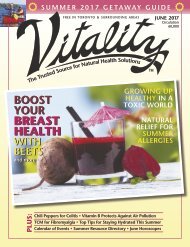Create successful ePaper yourself
Turn your PDF publications into a flip-book with our unique Google optimized e-Paper software.
side effect can be prevented by reducing the amount of magnesium<br />
given and providing it in a more absorbable form. If<br />
larger total daily doses of magnesium are required, divide the<br />
dose into smaller amounts and give it multiple times<br />
throughout the day.<br />
Oral magnesium citrate is inexpensive and fairly well<br />
absorbed. Other useful, but more costly, oral forms of magnesium<br />
include magnesium glycinate, magnesium gluconate,<br />
magnesium taurate, magnesium malate, and magnesium<br />
chloride. Avoid magnesium oxide (it absorbs very poorly)<br />
and avoid both magnesium glutamate and magnesium aspartate.(10)<br />
Magnesium sulfate is cheap and can be obtained<br />
transdermally by soaking in regular Epsom salt baths.<br />
How We Get Magnesium into Our Children<br />
• Oral magnesium supplementation:<br />
– We give our children a daily chewable magnesium tablet or<br />
oral liquid magnesium<br />
– We give our children a crushed portion of an adult magnesium<br />
tablet given with something tasty like honey, applesauce,<br />
or ice cream<br />
– For better absorption, we divide the dose and give magnesium<br />
between meals.<br />
• Transdermal Magnesium:<br />
– Our children take bi-weekly Epsom salt baths. We toss a<br />
handful or two of Epsom salt in their bath and have them<br />
soak for about 10 to 15 minutes. Our kids call it “water salt.”<br />
• Dietary Magnesium:<br />
– Our children eat a plant-based diet which provides magnesium<br />
from many sources. We include organic vegetables<br />
like carrots, baby spinach, and beet greens in our homemade,<br />
fresh, raw veggie juice. They drink this 2 to 3 times per week.<br />
We include wheat germ in bread, pizza dough, and smoothies.<br />
Cashews are offered for snacks. We sprinkle sunflower<br />
seeds on salads. We eat fish often, as well as bean and lentil<br />
soups. They love guacamole, bananas, and berries. They like<br />
peanut butter. They eat oatmeal, brown rice, and potatoes.<br />
Our children do not suffer from ADHD. But we don’t like<br />
to wait around for nutritional problems to show up. We see to<br />
it that our kids get the nutrients their growing bodies need.<br />
“Don’t take chances; take vitamins and minerals!” is our<br />
motto. Always will be.<br />
(OMNS Assistant Editor Helen Saul Case is the author of The Vitamin<br />
Cure for Women's Health Problems, and Vitamins & Pregnancy: The<br />
Real Story. She is coauthor of Vegetable Juicing for Everyone. Her<br />
newest book, Orthomolecular Nutrition for Everyone, was released in<br />
March <strong>2017</strong>.)<br />
Editor’s note: The above article is excerpted from a longer article<br />
submitted by the Orthomolecular News Service. To read the complete,<br />
unedited article, with the full list of references and resources at<br />
the end, go to: www.vitalitymagazine.com. The peer-reviewed<br />
Orthomolecular Medicine News Service is a non-profit and non-commercial<br />
informational resource. To get a free subscription to OMNS, go<br />
to: http://orthomolecular.org/subscribe.html. To visit the archive go<br />
to http://orthomolecular.org/resources/omns/index.shtml<br />
28 VITALITY MAGAZINE – MAY <strong>2017</strong> www.vitalitymagazine.com





